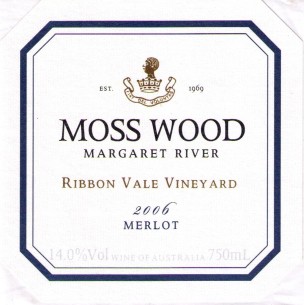Moss Wood Ribbon Vale Vineyard 2006 Merlot
Wine Facts
| Harvested: | 10/4/2006 |
| Bottled: | 30/1/2008 |
| Released: | 10/3/2008 |
| Yield: | 6.72 t/ha |
| Baume: | 13.10 |
| Alcohol: | 14.00% |
SOLD OUT
Tasting Notes
Moss Wood 2006 Ribbon Vale Vineyard Merlot is described by Keith as having violets and dark fruits aromas, a depth of mulberry, blueberry, earthy beetroot and rhubarb flavours with smoky, cedary oak in the background, and ripe tannins to finish. He sees the sweet dark fruits as giving a supple, smooth texture and comments that the oak is more overt on the palate than on the nose - at this stage of the wine's development.
Like Keith, Peter Forrestal is impressed by the Merlot's vanilla bean and mulberry aromas, ripe sweet fruit, depth and generosity of spicy plummy flavours, smooth texture and firm yet balanced finish. He comments that the wine is fully ripe and is deliciously drinkable.
Moss Wood 2006 Ribbon Vale Vineyard Merlot – Wine of the week – Huon Hooke, Sydney Morning Herald
Moss Wood 2006 Ribbon Vale Vineyard Merlot Merlot is not one of my favourite grapes but latest tastings suggest more Australian producers are starting to work out how to nail it. This one, from a leading Margaret River winery, is very stylish, seamless and elegantly structured. It has an aroma…
Vintage Notes
The 2006 vintage will be a surprise packet for those followers of Moss Wood who refuse to be distracted by the negative publicity the vintage has received and are prepared to take Keith's advice and try the wine.
'There are reasons to be cheerful' he says. The vintage was unusual for the region as it was long, cool and late. In fact, in 2006 there was 124 days between the flowering and the harvest of the cabernet grapes while a year later that interval was only 110 days. Consequently, the whole season started about two weeks late.
We have noted before that ripening of the grapes, in addition to the accumulation of sugar in the berries, involves changes to the fruit character. The most important change is the loss of the unwanted green notes of leaf and grass and their replacement by the dark fruit aromas of mulberry and redcurrant. This process is complex and driven by a number of things but one of the key drivers is high temperature. In summary, hours with the temperature above 32°C are crucial in driving out green flavours. The unwanted characters remain if there are insufficient hours above 32°C in a season. To give an example of how this can influence wine style, the great vintage of 2001 had 57 hours in that range, the warm year of 2003 had 67 hours, while the 2002 had only 22 hours.
Temperature data confirmed what the Moss Wood team believed that the 2006 vintage deserved to be ranked above 2002 for all its wines. The reds, in particular, are better because there was more hot weather (twice as many hours over 32°C) in the growing season leading to the 2006 harvest. In fact, the 45 hours above 32°C that 2006 experienced is just behind the 48 hours of the very highly regarded 1999. So while this was a challenging vintage, it presented no difficulties at Moss Wood.
Having looked at the temperature data in mid-January, the decision was made to leaf pluck aggressively in the Moss Wood and Ribbon Vale vineyards - to give the vines the best possible opportunity to ripen the grapes. It's worth noting that cool seasons do not affect cabernet franc at Ribbon Vale as it achieves full ripeness without any problems. Merlot, too, is at its best in cool vintages in Wilyabrup.
Production Notes
Production of the Ribbon Vale Vineyard reds follows the traditional Moss Wood approach. The grapes were handpicked, destemmed into open tanks, handplunged three times a day for extraction with the time on skins set according to taste. In this case, the Merlot was left on skins 12 days. After pressing, it was racked to barrel for the malolactic fermentation. Upon completion it was racked into tank, blended and then returned to barrel until January 2008. Extensive trials suggested that the wine would not be improved by fining and so it was sterile filtered and bottled at the end of January. The Merlot was aged in French Rousseau and Remond oak - 35% of

